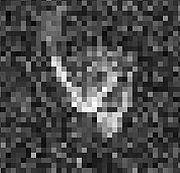Discovered by LINEAR (704) MPC designation (192642) 1999 RD32 Observation arc 7702 days (21.09 yr) Absolute magnitude 16.3 | Discovery date 8 September 1999 Discovered 8 September 1999 | |
 | ||
Aphelion 4.6785 AU (699.89 Gm) (Q) Discoverer Lincoln Near-Earth Asteroid Research | ||
192642 1999 rd32 top 5 facts
(192642) 1999 RD32, provisionally known as 1999 RD32, is a near-Earth asteroid and potentially hazardous object. It was discovered on 8 September 1999 by Lincoln Near-Earth Asteroid Research (LINEAR) at an apparent magnitude of 18 using a 1.0-meter (39 in) reflecting telescope.
With two precovery images from January 1995, the asteroid has a very well determined orbit with an observation arc of 17 years. It is known that 1999 RD32 passed 0.0093 AU (1,390,000 km; 860,000 mi) from Earth on 27 August 1969. During the 1969 close approach the asteroid reached about apparent magnitude 8.8. The similarly-sized 4179 Toutatis also reached that brightness in September 2004. 1999 RD32 passed less than 0.007 AU (1,000,000 km; 650,000 mi) from asteroid 29 Amphitrite on 17 January 1939.
Arecibo radar observations on 5–6 March 2012 showed that 1999 RD32 is approximately 5 kilometers (3 mi) in diameter and has an albedo of only a few percent. The two visible lobes suggest that 1999 RD32 is a tight binary asteroid or contact binary. About 10–15% of near-Earth asteroids larger than 200 meters are expected to be contact binary asteroids with two lobes in mutual contact.
